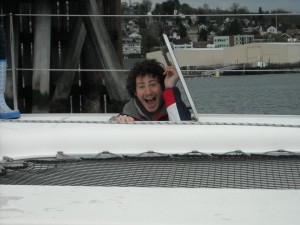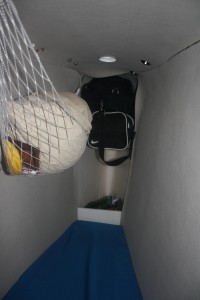We are NOT willing to compromise.
After an early start the group finally made it to Bellingham, WA where we met the Gato Verde, and Captain Todd, for the first time. Despite looking through past Beam Reach sailing photographs the “Gato†exceeded my expectations. When I was younger, I would always pester my dad to take me to the harbour to look out at the boats. This time, as I looked out onto the dock, a beautiful 42ft hybrid electric-biodiesel catamaran stared back at me. Our home for the next few weeks, the Gato stood out amongst the other vessels.  Never did I imagine that one day the ocean would be my classroom.
After having a brief tour of the boat—whilst it was safely fastened to the dock— we began exploring our cabins and bringing fancy science equipment on board. My cabin was particularly quirky because it was positioned at the front of the boat and was accessed by a floor hatch. Although it seemed small, on first appearance, there was more than enough space for me to sleep comfortably in addition to housing my luggage (yes, I still haven’t mastered packing lightly).  In fact, I felt fortunate that I had one of two single ‘rooms’. Another feature of the boat that I loved was the ‘trampoline’ that spread the breadth of the fore deck. Fortunately, as this was just a ‘practice cruise’, the group found many opportunities to lie on the netting overlooking the water. We were hoping to get some bowriding Dall’s porpoise, but, we had no such luck.
This particular four day excursion was intended as a way for us to adjust to life at sea. After a wobbly few hours we soon found our sea legs. Our mornings were structured around a chore schedule, and included tasks such as washing the decks, cleaning the heads, listening to the weather, and figuring out the tide tables. The person assigned ‘navigator for the day’ was required to propose a route to be followed.  Another person was appointed ‘science lead’, and was responsible for holding a morning meeting. Our morning meetings enabled us to devise science objectives for the day. Collectively, over the course of the trip, we were able to deploy a variety of science instruments. Such equipment included hydrophones; that allowed us to record ambient noise at Cherry Point (where a coal terminal has been proposed). In addition, we were able to measure for conductivity, temperature, and depth at several sites by deploying a CTD to varying depths. By doing this we were not only discovering the varying physical properties of sea water at different sites, but, also getting experience at handling heavy equipment on board a rocky boat. In addition to these experiments, we were also monitoring our own energy consumption. Daily, we kept records of our water consumption, sewage use, and amount of biodiesel remaining. These are all important factors to consider whilst sailing, especially when practicing sustainable science.
In addition to the science, and the log keeping, the group had a sailing lesson with Captain Todd. We learned the names of the various lines, in addition to having a crash course on wind. We each took turns at the helm where we attempted to tack. Tacking, or coming about, is a sailing manoeuvre where the bow of the vessel is turned through the ‘eye of the wind’. This is commonly done when the desired direction of travel is (nearly) into the wind. In order to tack on something of Gato’s size, it requires good team work and strong communication. I felt the group excelled at this.
Read More




 Twitter
Twitter LinkedIn
LinkedIn Facebook
Facebook